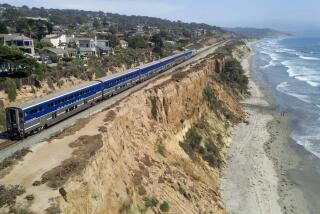Metal Shavings Yield Clues in Crash of Angels Flight
- Share via
Metal slivers have been found in the mechanism that drives Angels Flight, providing what may be important clues as to why one of the funicular’s twin cars broke loose last week, killing one passenger and injuring seven others.
National Transportation Safety Board investigator Dave Watson said Thursday that when engineers examined the machinery that operates the cable railway, “they could see metal filings where the ends of the splines have been chafed. . . . There is evidence of disengagement of a spline.”
Watson declined to characterize the chafing, but other sources close to the investigation said it could be an important sign of wear or metal failure that contributed to the accident.
Asked why the damaged splines escaped detection before the crash, Watson said “the part we’re looking at is well inside the system--not a thing you would see in a visual inspection.”
Watson explained that a 100-horsepower motor powers the “world’s shortest railroad,” which takes passengers on a 298-foot-long, one-minute ride from the lower station on Hill Street to the upper station atop Bunker Hill.
This motor, which is housed under the upper station, turns drive gears that are attached with splines to two counter-rotating axles. Each axle turns a planetary gear system that spins a large metal spool. A cable around each spool is attached to one of the cars. When one car goes up, the other goes down.
The splines at one end of each axle are ridges like the teeth in a gear. These splines are designed to provide a tight coupling with the drive gear system. The metal slivers and chafed splines were found on the axle for the car that broke loose.
Watson said the damaged splines were discovered during examination by engineers from the firms that manufactured the various components of the drive system. He said the damage was not visible until portions of the machinery had been removed.
A large crane was trucked in Wednesday to remove the damaged cars for storage in a downtown warehouse. Watson said the same crane will be used early today to pull out several parts of the drive assembly that weigh a total of more than three tons.
“With those out of the way, we’ll be able to get down to the gear assembly and look at that,” he said.
Watson said the engineers also will be looking at the braking system on the pulleys, which was supposed to prevent the cars from breaking away in the event of a drive system failure.
Watson, who is director of the NTSB’s Western regional office, said of the investigation, “We’re just scratching the surface.”
(BEGIN TEXT OF INFOBOX / INFOGRAPHIC)
Looking for Problems
Investigators have found metal slivers in the mechanism that drives the Angels Flight cars. A 100-horsepower motor powers the railway, which takes passengers from the lower station on Hill Street to the upper station atop Bunker Hill. How the mechanism works:
*
Note: not to scale.
Source: Community Redevelopment Agency
More to Read
Sign up for Essential California
The most important California stories and recommendations in your inbox every morning.
You may occasionally receive promotional content from the Los Angeles Times.













